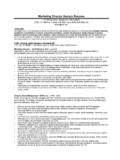Transcription of A NOTE ON THE PRODUCT-MARKET GROWTH …
1 A NOTE ON THE PRODUCT-MARKET GROWTH matrix Randall L. Schultz University of Iowa The PRODUCT-MARKET GROWTH matrix is a standard feature of marketing textbooks despite its being described inconsistently and in some cases illogically. This paper reports on a revised matrix that clarifies the definitions of product GROWTH strategies. November, 2004 2 BACKGROUND While companies can grow sales through corporate-level actions such as diversification ( , purchasing another company) or strategic business unit-level actions such as the integrative GROWTH strategies of backward or forward integration, the principal ways that companies can grow the sales of a brand are captured in the " PRODUCT-MARKET GROWTH matrix ." The PRODUCT-MARKET GROWTH matrix was created by Igor Ansoff (1957) as a way to think about how a company could increase its sales. It is found in most marketing and strategic management textbooks (although the discussion and examples vary greatly).
2 With a few important modifications it can be very useful as a guide for brand or product managers who are interested in increasing brand sales. Almost every marketing textbook explains the PRODUCT-MARKET GROWTH matrix in a different way, and many of the explanations are inconsistent or don't make sense. In a study of marketing textbooks (see Appendix) this is what we found: Definitions were inconsistent between books Definitions were inconsistent within books Examples were inconsistent within books In other words, not only did different authors interpret the PRODUCT-MARKET GROWTH matrix in different ways, but the same authors often used inconsistent definitions and examples in their own textbooks! Here are some examples. Aaker (1988) says that selling to nonusers is an example of market development but Guiltinan and Gordon (1982) say that selling to nonusers is market penetration. Lewison (1996) says that serving new groups of customers (new market segments) is market development, giving the example of a fashion designer who develops a less-expensive line of clothing for the mass market , which surely is a strategy to "identify unmet consumer needs and develop new products to meet those needs," this being his definition of product development.
3 3 Dalrymple and Parsons (1995) say that "promotion of more frequent and varied usage among current users" ( market penetration) involves finding and promoting new uses (italics added) among existing customers, which seems like it would be finding new target markets for the product , Lamb, Hair and McDaniel's (1992) definition of market development. For example, the makers of Silly Putty have found a new target market in adults who use the product as a stress reducer, so in this case the new use implies a new target market . Aaker says that developing new products for existing markets such as Arm & Hammer introducing a new laundry detergent is product development even though laundry must be a new market since it is a new market segment, his definition of market development. Aaker further notes that developing new generation technologies is product development, but Booth (1990) gives the example of developing an entirely new product based on new technology as one showing "diversification" ( product diversification).
4 Urban and Star (1991) describe "enter new markets with new products" ( product diversification) as undertaking major product design and implementation programs, something that virtually everyone else calls product development, even them! Their definition of "new products to serve existing markets better" ( product development) is "emphasis on product development," exactly the same thing. For the most part, any discussion of product diversification in these textbooks is about corporate diversification or without any examples at all. And so it goes with the marketing textbooks. Even the originator of the PRODUCT-MARKET GROWTH matrix , Ansoff (1951), is inconsistent. He describes market development as "a strategy in which the company attempts to adapt its present product line (generally with some modification of the product characteristics) italics added to new missions but then goes right on to describe product development as a strategy that "retains the present mission and develops products that have new and different characteristics such as will improve the performance of the mission.
5 " ( ). To be fair, he's talking about different missions, but the fact of the matter is that everyone else is talking about product changes as the point of differentiation between the two concepts. 4 Our conclusion was that, after more than 50 years of confusion, it was time to do product development on the PRODUCT-MARKET GROWTH matrix itself. A REVISED matrix The revised PRODUCT-MARKET GROWTH matrix is shown in Table 1. ------------------------------ Insert Table 1 about here ------------------------------- To simplify, consider a brand and a product to be the same thing, , a named product (brand). Unless discussing the product life cycle where product will refer to product category this will make it easier to understand and use the PRODUCT-MARKET GROWTH matrix .
6 Each separately-named product in a product line can be considered a different product . For example, Cheerios and Honey Nut Cheerios are two products. But some brands cover multiple models, as in automobiles. Honda Civic is a brand (separate from Honda Accord), but Honda Civic DX and Honda Civic LX are models of the brand. The keys to understanding this distinction are where the marketing focus is and how brand management is organized. The Honda Civic is marketed separately from the Honda Accord, probably using different product management groups for each brand. But this would not be the case for different models of Civic or Accord any more than it would be the case for different package sizes of Cheerios. What is different in our use of the PRODUCT-MARKET GROWTH matrix concept is the cell on new products for new markets. This is called here product diversification not just diversification to signify that it is an aspect of product management decision making, not corporate decision making.
7 5 A company would pursue product diversification only if the product managers (possibly the group product managers or managers of the strategic business unit that the product is in) wanted to grow sales in this way. In other words, like other cells in the PRODUCT-MARKET GROWTH matrix , it is a way to manage a brand in this case by basically redefining brand strategy. In some cases, product diversification may even result in a new brand management group. GETTING NEW PRODUCTS AND MARKETS STRAIGHT The first thing to remember is that the PRODUCT-MARKET GROWTH matrix is always used from the point of view of a company. So a new product is one that is new to the company, not necessarily to the market . When Mercedes-Benz brought out their new SUV, the M-Class, it was an example of product development because they had never sold an SUV before. Before considering what constitutes a new market , let s look more closely at what new products are.
8 A new product is simply any modification of a current product . The modification could involve no change in brand name, a new brand name that is a brand extension or a new brand name with a separate identity. For example, Duracell added the feature of a battery-life indicator to its batteries, but didn t change the name under which the product was sold nor did the feature itself have a special name. The feature was described on the packaging and in advertising copy, but not named. However, sometimes a product is modified and the modification or new feature is named to bring more attention to the feature. American Express added a new feature to all of its charge and credit cards called Private Payments, which allowed its customers to use randomly-generated numbers for each separate purchase occasion rather than their card number itself. Both are examples of product development. Sometimes a company thinks it can better serve a market by creating a brand extension.
9 Duracell did this when they created a new line of batteries called Duracell Ultra. Fiskars, on the other hand, decided to create a separate brand identity for their lower-priced alternative to Fiskars scissors and named the new product DuraSharp. These are both examples of product development too. 6 A new market is also defined in terms of the company s point of view: one that is new to the company. The current market that the company is selling the brand in has a certain market potential. A new market would be any market that expands that potential because it offers the company a chance to market to a new customer base or to its current customer base with new uses for the product . Several years ago, Packard Bell NEC, then the leading marketer of personal computers to consumers through retail outlets such as Best Buy, decided to sell some of their current products to business customers a new institutional segment. An article in The Wall Street Journal said that they were trying to attract new customers and went on to explain how businesses buy differently from consumers.
10 This would be an example of Packard-Bell following a market development strategy to grow sales. Since the point of view is a company and since any one product must be either new to the company or not, the first thing to do is decide which side of the product GROWTH matrix a company s strategy is on. For a new product , the only two options are product development and/or product diversification. For a current product , the only options are market penetration and/or market development. Note the and/or. The strategy for a current product , for example, could be both market penetration and market development, if, say the company was both advertising in certain media to current customers and, at the same time, advertising in different media to a new customer base. Similarly, the strategy for a new product could involve both product development and product diversification. market PENETRATION Traditionally we talk about four main ways that a company can increase the sales of a current brand using a market penetration strategy, , selling a current product in a current market .






